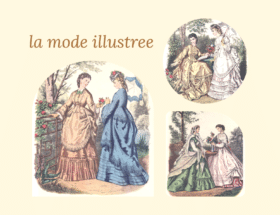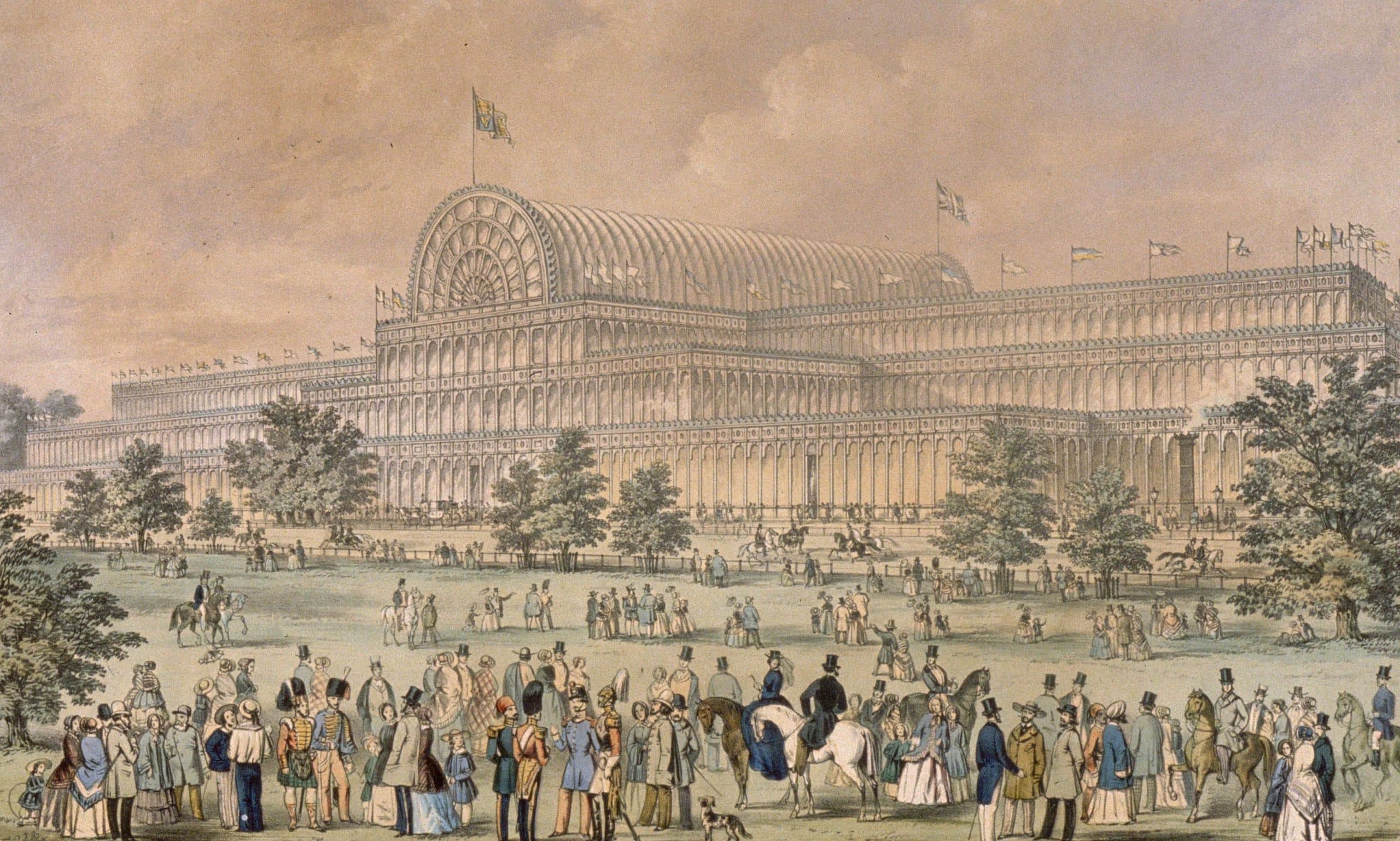The Edwardian Hostess's Rôle Edwardian Fashion History 2
By Pauline Weston Thomas for Fashion-Era.com

The Edwardian Hostess's Rôle Edwardian Fashion History
- The Rôle of the Edwardian Society Hostess
- The London Summer Season - The Scene of Action
- Autumn and Winter Edwardian Country House Season
- The Royal Visit of King Edward VII and Queen Alexandra
- Arranging the Edwardian Guest List
- A Typical Edwardian Weekend House Party
- Noah's Ark Domed Travel Trunk - Clothes for a Weekend
- Cynthia Asquith and her Edwardian Recollections
- Edwardian Mourning Clothes
- Sweet Pea Colours at the Coronation Ball of 1901
- The Treadmill Round of Ordering the Edwardian Dinner
- Suffragettes and Votes for Women
The Rôle of the Edwardian Society Hostess
The image of the lost golden age owes much to the rôle of the society hostess. Her duty was to cultivate the concept of unashamed luxury, splendour and display associated with high society. She achieved this by two methods. Firstly she wore a different ensemble for every separate activity of the day. Secondly she entertained in a style where no expense was spared. Each activity complemented the other. The extravagant fashions demanded the existence of a 'scene' and the 'scene' demanded ostentatious display making each a perfect foil for the other.
The London Summer Season - The Scene of Action
The 'scene' varied with the months, but the typical society hostess always had some fashionable place to visit and some 'occasion' at which to be seen.
Her social year began with a round of parties and balls that lasted for the three month London Summer Season. The activities demanded a range of ball gowns in white, silver, gold or pastel sugar almond tints, trimmed with passementerie and narrow velvet ribbon.
Although evening dresses faithfully adhered to the line of day gowns, they were more sumptuous with décolleté round or square necklines. At night off-the shoulder gowns exposed their shoulders and highlighted lacy or transparent flounced sleeves.
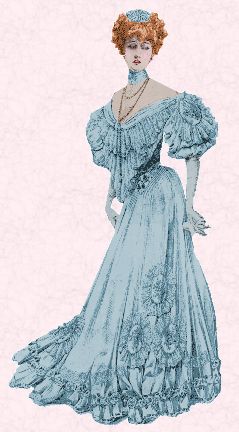
In August and September, there were Cowes week, the Scotland grouse season and the health resorts of Marienbad or Bath to visit. With such contrasts in scenery a lady's trunks would be packed with a variety of appropriate day dresses, walking gowns, tea gowns, evening gowns, sports ensembles, suits, shawls, coats, capes, hair ornaments, and fur wraps, as well as many other essential items.
Autumn and Winter Edwardian Country House Season
Then in mid-September the country house season began. Many a hostess found herself very busy until February, with perhaps only a short break in London for the Christmas week. Finally time could be idled away in the warmer climate of the South of France, at Cannes or Biarritz.
As this was a little too early for high society to accept anything other than a pale complexion, the hot French sun was shielded by a frilly little parasol. This item also served as a fashion accessory to a matching ensemble. In the Edwardian era only working people who had no choice but to work in the open air, displayed a tanned brown skin.
A white complexion was associated with gentility and leisure until Coco Chanel popularized tanning. Then in the 1920s the rich sought to gain a tan to show they could afford the leisure time to holiday in exotic climates.
London Society Edwardian Balls
Princess Marie Louise in the book My Memories of Six Reigns, recalls that,
'London society was brilliant. I might even say glamorous... .... balls, receptions and of course large dinner parties took place every evening, and it was quite a usual occurrence to go to more than one ball the same night...... There was no necessity to entertain outside one's own house, as in those days the Dorchester House, Grosvenor House, Landsdowne House, Derby House, Stafford House - all these beautiful residences were still inhabited by their owners.'
The Royal Visit of King Edward VII and Queen Alexandra
The aim of every Edwardian hostess, whether in town or country, was to be considered socially eminent. The most preferred occasion would have been a weekend house-party, entertaining King Edward VII and Queen Alexandra.
Any weekend house-party demanded immense preparation, but a house-party that included Royalty taxed the hostess to her limit. Sumptuous food and twelve course dinners were essential and shooting parties meant that lavish outdoor picnics were required.
An Edwardian Shooting Party Photo.
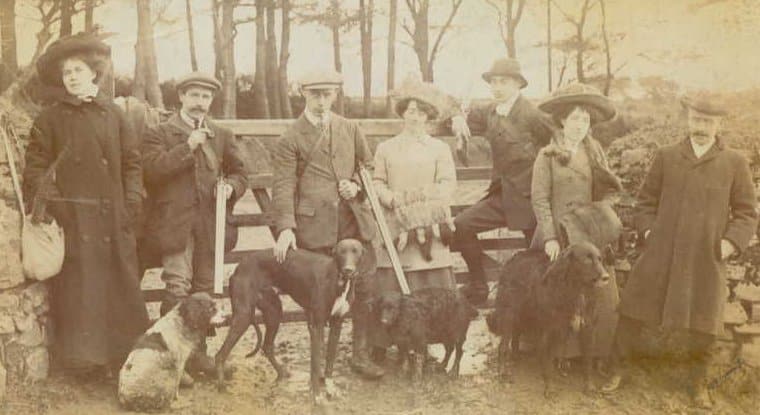
Houseguests needed suitable clothes for every occasion. Thumbnail enlarges
Details of the type of organisation demanded of the hostess, were revealed in an article called 'Entertaining Their Majesties,' in a 1904 issue of The Lady's Realm magazine:-
'Once the visit is a settled thing, special and vast preparations have to be made. Few outside the charmed circle realise the magnitude of these necessary arrangements.
Naturally much depends on the host and hostess..... the work of preparation is magnified to a very considerable extent, for re-decoration and re-upholstery must inevitably take place; also other rooms are depleted of choice articles of furniture and much that is new is ordered for the occasion.'
Arranging the Edwardian Guest List
Compared to the hostess's task of arranging a guest list acceptable to both King and Queen, re-decoration of houses with up to one hundred rooms was only a small problem.
The society hostess consulted both royals about their special desires that certain people should or should not be guests. The hostess had to have the ability to assess changes in the amours of her guests, and then discreetly arrange sleeping accommodation according to currently desired proximities. The whole purpose of the house-party was pleasure.
A Typical Edwardian Weekend House Party
House parties were carefully arranged to be amusing. At Eaton Lodge, the home of Lord and Lady Brooke, guests would arrive on a Friday evening to flower filled rooms, a splendid menu and charming servants.
During the day they might ride in the park, shoot or hunt until teatime, when the ladies would swan about in ultra feminine long sleeved tea gowns.
If the King and Queen were present they might not appear until lunchtime when they would dine with the host and hostess. After lunch the Royals might plant a commemoration tree and then join the house party for tea, before changing for dinner.
Then the King would lead in the hostess to the bedecked dining table. The table would overflow with engraved and cut glass, gold plated bone china and centre piece epergnes dripping with hothouse exotic flowers and fruit. To call the rich idle would be a fallacy. They worked hard to enjoy every pleasure available.
Noah's Ark Domed Travel Trunk - Clothes for a Weekend
For country house visiting, clothes for every separate occasion were a must. For a brief weekend stay a society lady would take at least one huge domed trunk called a 'Noah's Ark', possibly more, plus hat boxes and a heavy dressing case. These contained clothes enabling her to change up to half a dozen times a day. A lady would never wear the same outfit twice during one stay. A hostess had the advantage of having her clothes at hand.
Cynthia Asquith and her Edwardian Recollections
Cynthia Asquith recalled the inconvenience of country house visiting as a guest in her memoirs, Remember And Be Glad:
'.... A large fraction of our time was spent in changing our clothes, particularly in winter when you came down to breakfast ready for Church in your "best dress" made probably of velvet.... .After Church you went into tweeds. You always changed again before tea into a tea gown... however small your allowance a different dinner dress for each night was considered necessary.
Thus a Friday to Monday party meant taking your "Sunday Best", two tweed coats and skirts with appropriate shirts, three evening frocks, three garments suitable for tea, your "best hat" - probably a vast affair loaded with feathers, flowers fruit or corn - a variety of country hats and caps, as likely as not a riding habit and a billy-cock hat, rows of indoor and outdoor shoes, boots and gaiters, numberless accessories in the way of petticoats, shawls, scarves, ornamental combs and wreaths, and a large bag in which to carry your embroidery about the house. '
Edwardian Mourning Clothes
To already overflowing baggage, the hostess would remind guests to add mourning clothes if the house party included members of Royalty. The Lady's Realm which was really a magazine for those who looked to Court Circles for inspiration on which to model their lives, advised hostesses that guests should never go unprepared,
'... one is never sure when mourning may be demanded ... and it is etiquette that when visiting where the King and Queen are present every guest must appear in exactly the same degree of mourning or half mourning.'
Then, as now, mourning was a social symbol used to expose private feelings. Only the bitter realism of the Great War made it repulsive for most people's taste. But typical of the Edwardian era, it was considered essential to observe the rules of society, and the wearing of mourning was taken to extremes.
Sweet Pea Colours at the Coronation Ball of 1901
At Court after the death of Queen Victoria, society ladies waited hopefully for the King and Queen to stop wearing mourning. Formality decreed that ladies don only black, whilst Queen Alexandra continued to observe mourning.
She shocked everyone at her Coronation Ball in 1901 by appearing in a light gown amid a sea of deep black. From that moment hostesses copied many of the fashions she favoured.
It was Queen Alexandra who introduced the sugar almond and sweet pea colours of the early 1900s, a welcome change from the garish aniline-dyed clothes of the 1890s. She was considered the great Royal fashion leader of her day.
A New World Beckons
The Treadmill Round of Ordering the Edwardian Dinner
For some the formality of their social world became too much of a strain.
Using spare time and being the perfect hostess was a full time job.
To escape from the endless entertaining many patronized the Ladies' Automobile Club.
Fashion history moment in time - A motoring outfit 1905.
- Costume Drawings 1914-1915
- Costume Drawings 1916-1917
- 1910-20 Black Costume Silhouettes
- 1910-20 Outline Costume Silhouettes
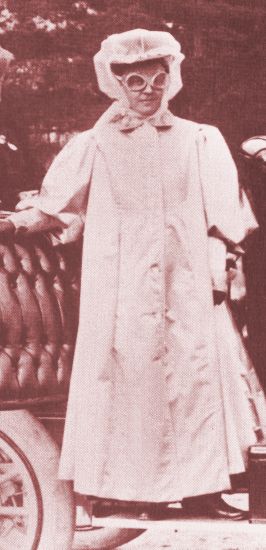
One of the main purposes of the Club, whose meeting place was at Claridge's Hotel, was to give the hostess a rest from the ceaseless routine of grappling with cooks, butcher's orders, and the mathematics of the menu.
The club was for the female automobile aristocracy and it aimed to remain exclusive, a large number of members being titled society hostesses seeking refuge from the treadmill of ordering the dinner and the tedium of spending all their time changing their clothes.
Suffragettes and Votes for Women
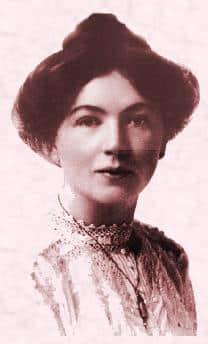

Other diversions for bored thinking women included campaigning for the vote. Emmeline Pankhurst formed the Women's Social and Political Union (WSPU) in 1903. The most famous campaigners of women's suffrage were Emmeline and Christabel Pankhurst.
Despite great political opposition and personal hardship the campaigners called suffragettes fought on for women's rights until the outbreak of World War 1 in 1914.
Women's energy and skill throughout the war years won them such praise that in 1918 all women over 30 were given the vote with women over 21 able to become MP's.
Socially elite Lady Nancy Astor (1879-1964) was elected to Parliament in 1919 and was the first women to take her seat at Westminster.
By 1928 all women over 21 were given equity with male voting rights and it was called the 'flapper vote'.
Footnote:-This page was partially based on content I updated from a dissertation I first wrote in 1979. The dissertation a Comparative Study Between the Rôles of the Edwardian Hostess and the Edwardian Seamstress looked at the symbolism behind Edwardian dress and the rôles of women in Edwardian society.
In particular it examined the rôle and high lifestyle of Edwardian society hostesses compared with the degrading working conditions and impoverished lifestyle of the seamstresses that made clothes for hostesses.
